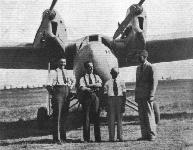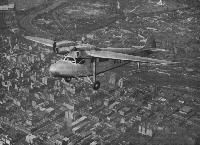
Tugan LJW.7 Gannet
В середине 1930-х годов уинг-коммандер Л. Дж.Уокетт из ВВС Австралии для компании "Cockatoo Dockyard & Engineering Company" разработал прототип самолета Codock, на его основе был спроектирован легкий транспортный Tugan LJW.7 Gannet. Этот высокоплан строился "Tugan Aircraft Ltd" из Сиднея и был оснащен двумя моторами Gipsy Six по 200 л. с. Прототип Gannet выполнил первый полет в октябре 1935 года, но вскоре разбился. Кроме прототипа построено еще шесть или семь самолетов. Производство прекратили после покупки "Tugan" фирмой "Commonwealth Aircraft Corporation". Самолеты состояли на вооружении ВВС Австралии и использовались в качестве санитарных до конца Второй мировой войны.
Описание:
- Tugan LJW.7 Gannet
- Flight, September 1933
A WACKETT MACHINE FOR "SMITHY”
Фотографии
-
Air Pictorial 1956-08 / Photos by request
Регистрационный номер: VH-URP RECOGNITION TEASER - Not the Tugan Gannet but the equally rarely-illustrated Wackett Codock of April 1934, built by the short-lived Cockatoo Island Dockyard & Engineering Co., Pty. W /Cdr. L. J. Wackett is better known for his wartime Boomerang fighter and primary Wackett Trainer. Intended as a five-seat light transport, the Codock prototype, VH-URP was powered by two 150-h.p. Napier Javelin inlines. The design was not proceeded with and W/Cdr. Wackett left to join Tugan Aircraft/General Aircraft, Pty., Ltd., where he produced the twin Gipsy Six-powered Gannet.
-
Flight 1939-02 / Flight
Регистрационный номер: A14-1 The Gannet is built by the Commonwealth Aircraft Corporation and is used mainly for survey. It is now fitted with Gipsy Six Ils.
-
Мировая Авиация 246
Регистрационный номер: A14-5 Gannet использовались в Австралии ограниченно. С экипажем из одного летчика самолет мог брать на борт до шести пассажиров или раненых на носилках, или грузы.
-
Air Enthusiast 1997-01 / C.Owers - Comparative 'Maggie'
Регистрационный номер: A14-3 Tugan Gannet A14-3 and Magister outside a typical late 1930s RAAF hangar. The Gannet was another Wackett design. Tugan was acquired by CAC as the core on which it was to build its factory and took over the Gannet production line as evidenced by the CAC logo on the fin.
-
Flight 1934-05 / Flight
ALL-AUSTRALIAN: On March 6 successful first trial flights of Sir Charles Kingsford Smith's Australian-built monoplane, the "Codock" (Napier "Javelin" engines), were carried out at Mascot Aerodrome. Here we see a portion of the "Codock," with (from left to right) Wing Commander Wackett (designer and builder), Sir Charles Kingsford Smith, Sqd. Ldr. (Tiny) White (who will fly the machine to New Zealand), and Mr. M. P. Allsopp (Aviation Representative of the Vacuum Oil Co., Pty., Ltd.). Plume and Mobiloil Aero W. were used during the test flights.
-
Flight 1934-06 / Flight
AUSTRALIAN-BUILT: The "Codock" monoplane (Napier "Javelin" engines) flying over Melbourne.
-
Flight 1933-11 / Flight
THE "CODOCK": In our issue of September 14 we published a side elevation of the machine designed by Wing Com. Wackett for Sir Charles Kingsford-Smith. This photograph of a scale model gives an even better idea of the "Codock." The engines are two Napier "Javelins" and the machine will have a wing span of 52 ft., a tare weight of 2,620 lb., and a gross weight of 4,500 lb. There will be seating accommodation for six passengers, and the range with full load is calculated to be about 500 miles.
- Фотографии







